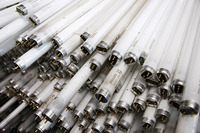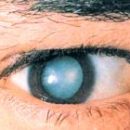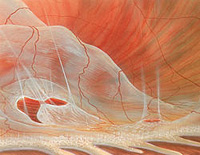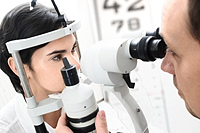The problem of the exhaustibility of resources and the urgent need to save electricity is one of the most acutely discussed in the world. Governments of states call on to switch to energy-efficient technologies and make laws aimed at increasing energy efficiency. The discontent of the population is caused by the fact that in the introduction of new technologies, instead of morally obsolete, it is necessary to first put considerable funds, and the savings occurs significantly later.
Content
 Over the years, one of the most popular energy-saving lamps has become luminescent. The power consumption of this lamp is almost 5 times lower than that of the incandescent lamp, and the service life is 6000 hours against 1000 hours. Compact fluorescent lamps (CLL) were widespread due to the simplicity of installation: they have a standard base and mounted directly to the place of incandescent bulbs.
Over the years, one of the most popular energy-saving lamps has become luminescent. The power consumption of this lamp is almost 5 times lower than that of the incandescent lamp, and the service life is 6000 hours against 1000 hours. Compact fluorescent lamps (CLL) were widespread due to the simplicity of installation: they have a standard base and mounted directly to the place of incandescent bulbs.
The main problem of luminescent lamps, which manufacturers do not hide, is the presence of mercury, which provides a glow in this lamp. If you break the lamp at home, so as not to receive poisoning of mercury couples, it is necessary to take measures to demarize the room: it is necessary to carry out mechanical cleaning from mercury compounds and arrange the air ventilation for several hours. Also improper disposal of fluorescent lamps can cause a large-scale damage to the environment and health of the population: mass accumulation of light bulbs in urban dumps will lead to mercury in soil and water.
But only mercury in luminescent lamps can harm human health?
Secret of the glow
CLL is a twisted tube filled with a mixture of inert gas and mercury vapor. When electricity passes, the connection begins to glow almost invisible to ultraviolet radiation. It seems it becomes when passing through the fluorescent composition – Luminoforn, applied on the walls of the tube. But not all UV radiation is converted, part of it passes through a layer of phosphor in an unchanged form, and in the aging and destruction of the luminophore layer, the percentage of UV radiation passing through it increases.
The harmful effects of solar ultraviolet on the skin is widely known: the destruction of collagen and elastin, premature aging and flaws of the skin, and the likelihood of active growth of cancer cells. Unfortunately, the glass of the fluorescent lamp delays not all types of ultraviolet rays, and, falling onto the skin of a person, they have no less negative impact than solar.
There are studies showing that light fluorescent lamps can cause migraine and even epilepsy attacks. Due to ultraviolet radiation of fluorescent lamps in people with sensitive skin, rashes, eczema, psoriasis and swelling may appear. Special danger of UV rays are presented for delicate skin of babies.
Why flickers?
The second danger that fluorescent lamp pays – This ripple – These are invisible to the unarmed eye of the flicker of light, which arise due to oscillations in the supply voltage. The cunningness of the pulsation is that falling on the retina of the eye, it is adjusted and perceived by a person like smooth light. However, the negative effect of light fluctuations on the human body is established in numerous studies of Russian and international experts and scientists. Pulsation extremely negatively affects the brain, and as a result, it causes increased fatigue and poor well-being.
Most researchers noted the negative impact of the pulsation of light on human performance both with a long stay in conditions of pulsating lighting and in short, for 15-30 minutes.
Many international and Russian studies have proven that the pulsation of luminescent lighting has a negative impact on the central nervous system, and to a greater extent – Directly on the nervous elements of the cerebral cortex and photoreceptor retinal elements. Head of labor hygiene and general hygiene «Center for hygiene and epidemiology in the Republic of Mari El» Belyanina A.IN. It notes the danger of luminescent lighting for the visual performance of man, especially in students, first of all, schoolchildren have up to 13-14 years old when their visual system is still formed.
Development of technologies and tightening Norms SNIP and SanPyne led to the appearance of electronic flow-regulating agents (EPR), reduced ripples. These devices smooth the oscillations, but to make light as permanent and even for only the most expensive and high-quality EPR, which are not maintained by the competition of cheap Chinese lamps, which are oversaturated the market.
According to Russian sanitary standards, the pulsation of light when working with a computer should not exceed 5%, but when job certification, under working conditions, it turned out that the value of the ripple coefficient to more than 80% of jobs 2-4 times higher than the established norms. What ripple near lamps installed at home can only be checked if there are special professionally equipment.
Going into the past incandescent lamp also has a ripple coefficient. Voltage fluctuations also affect the hot tungsten thread. But she does not have time to cool so quickly, so the flicker is somewhat smoothed – Pulsation is approximately 13%.
Almost fully the problem of ripples is solved in confidently conquering LED lamps – High-quality lamps have a pulsation coefficient up to 1%. The indisputable advantage of LEDs is the lack of mercury, lead and other harmful compounds, and therefore special recycling measures are required. Texew L.M., The head of the regulation of the rationing and hygienic examination of the health of hygiene and the protection of children's health and adolescents The RAMS, conducted an experimental study with the participation of volunteer volunteers from 20 to 35 years old comparing the effects of luminescent and LED lamps for psychophysical indicators of a person. The results of the experiment revealed the advantage of work under LED lighting compared to luminescent. Teksheva finishes its study in the following words: «I believe in the future of LED lighting!»









